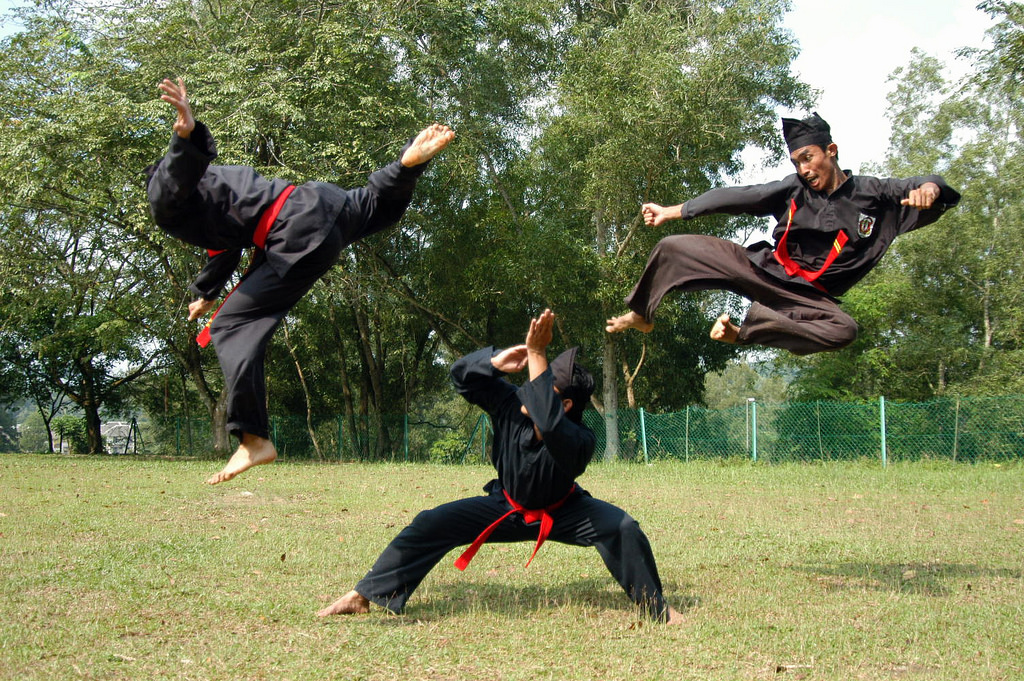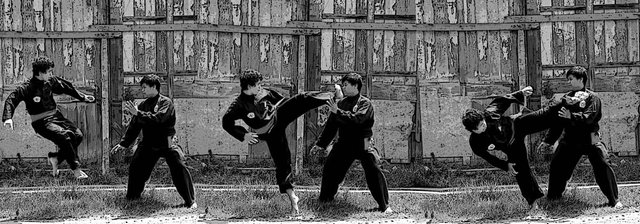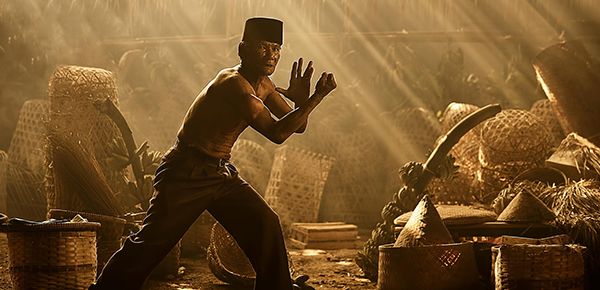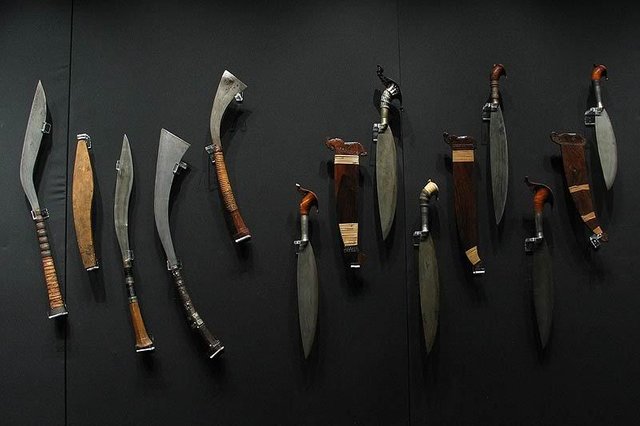!! Most deadliest Martial arts style : Pencak Silat !!

Sumatra, Java, Bali and a hundred other smaller islands … these are lands of mountains and green jungles, the dark heart of Joseph Conrad’s tales and the home of the Balinese temple dancers. At one time, though, they were islands of violence — swept by the Japanese in World War II, racked by the struggle for independence from the Dutch and pummeled by years of internal civil war. So it’s not surprising that the people of these islands developed some effective methods for combat and self-defense. These fighting systems drew on boxing, wrestling and weaponry — and were practiced not only for physical defense but also for attainment of higher psychological ends. In time, what had become a collection of Indonesian fighting systems became martial arts in their own right. The official name used to indicate more than 800 martial arts schools and styles spread across more than 13,000 islands in Indonesia is called "pencak silat". However, this is actually a compound name consisting of two terms used in different regions. The word "pencak" and its dialectic derivatives such as "penca" (West Java) and "mancak" (Madura and Bali) is commonly used in Java, Madura and Bali, whereas the term "silat" or "silek" is used in Sumatra. The ambition to unify all these different cultural expressions in a common terminology as part of declaring Indonesia's unity and independence from colonial power, was first expressed in 1948 with the establishment of the Ikatan Pencak Silat Indonesia (Indonesian Pencak Silat Association, IPSI). However, it could only be realized in 1973 when representatives from different schools and styles finally formally agreed to the use of "pencak silat" in official discourse, albeit original terms are still widely used at the local level.

Pencak silat plays an important role in Indonesia's history. Since the age of ancient Indonesian Hindu-Buddhist kingdoms like Srivijaya, Majapahit, and Kingdom of Sunda, these kingdoms used pencak silat to train their soldiers and warriors.Archaeological evidence reveals that by the sixth century A.D. formalized combative systems were being practiced in the area of Sumatra and the Malay peninsula. Two kingdoms, the Srivijaya in Sumatra from the 7th to the 14th century and the Majapahit in Java from the 13th to 16th centuries made good use of these fighting skills and were able to extend their rule across much of what is now Indonesia, Malaysia and Singapore. According to tradition of Minangkabau, their Silek (Minangkabau pencak silat) can be traced to the fore father of ancient Minangkabau people, Datuk Suri Dirajo. It is said that according to old Javanese poetry, Kidung Sunda, the sentinels of the Prabu Maharaja Sunda exhibited great skill in the art of pencak silat when they escorted Princess Dyah Pitaloka to Majapahit as a potential bride for King Hayam Wuruk, and faced indignities that greatly affronted their honour[2]. In a battle that ensued at the Bubat field (1346), the Sundanese forces fought to the last drop of blood, using special pencak silat moves and various weapons. Albeit the pencak silat styles employed in combat were different, we can still draw the conclusion that in Javanese kingdoms throughout the archipelago, pencak silat served the same function: to defend, maintain or expand territory.
There is no overall standard for Pencak Silat. Each style has its own particular movement patterns, specially designed techniques and tactical rationale. The richness of terms reflects a wide diversity in styles and techniques across the regions due to the fact that pencak silat has been developed by different masters who have created their own style according to their preferences and to the physical environment and social-cultural context in which they live. For example, West Java, Central Java and West Sumatra. West Java is inhabited by a specific ethnic group with specific cultural and social norms. For them, pencak silat is part of their way of life or as they say, "the blood in their body". In their language they say "penca" or "menpo" to indicate their main four styles Cimande, Cikalong, Timbangan, and Cikaret and all the schools and techniques which have derived from them. The Sundanese people have always utilized penca/menpo for self-defense and recreation, and only recently have started to use it as a sport in national and regional competitions.

The bela-diri (self-defense) aspect of penca can be very dangerous. Therefore it was kept secret, especially its mystical aspect where only selected students were taught in phases. Penca as an art (penca ibing) has been a source of inspiration for traditional Sundanese dances such as Jaepongan, Ketu'tilu', Dombret, and Cikeruhan and actually it resembles dance in its use of music instruments. These instruments, called "pencak drummers" (gendang penca), are devoted exclusively to penca performances and consist of two sets of drummers (gendang anak dan kulantir), a trumpet (tetet) and a gong. Pencak performances also use standard music rhythms such as tepak dua, tepak tilu, tepak dungdung, golempang and paleredan. Penca as art is not considered dangerous and can be openly shown to everyone. From generation to generation until today, penca performances animate wedding parties, rituals of circumcision, celebrations of the rice harvest and all kind of national festivities.
As with most ancient fighting arts, pencak silat historically prioritized weapons over unarmed combat. While this is usually not the case today, all pencak silat schools include weapons to some degree of importance. While pencak silat includes a wide array of weapons, the following are considered standard in all classical styles. In addition to these, many systems include a specialty or "secret" weapon taught only to advanced students.

• Toya: Staff usually made of rattan but sometimes wood or metal. Typically measures 5–6 feet long and 1.5-2 inches in diameter.
• Tombak/Lembing: Spear or javelin made of bamboo, steel or wood that sometimes has horsehair attached near the blade.
• Parang: Machete-like chopper, ranging from 10 to 36 inches long
• Golok: Heavy cleaver measuring 10-20 inches long. The blade is heaviest in the centre
• Pisau: Any short-bladed knife
• Kris: Double-edged dagger made by folding different types of metal together and then washing it in acid.
• Sabit/Celurit: A sickle, commonly used in farming, cultivation and harvesting of crops.
• Tongkat/Galah: Short stick or cudgel
• Pedang: Sword, most often single-edged and either straight or slightly curved. Usually measures 15-35 inches overall with a blade upward of 10 inches long
• Klewang: Single-edge longsword with a protruding notch near its tip
• Chabang: Short-handled trident, literally meaning "branch"
• Selendang: A silk that can be used for strangling, grappling and whipping

Content credit:
http://www.counterforcountermartialarts.com/articles/the-devastating-art-of-pentjak-silat/
http://www.silatma.com/silathistory
Image credit : http:// google.com
Special Thanks to :
@blueorgy
@originalworks
#Originalworks
@minnowpond
@followforupvotes
@minnowsupport
@banjo
@dorabot
@dropahead
@gaman
@abasinkanga
@skreza
@kevinwong
@craig-grant
@juneaugoldbuyer
@blakemiles84
@bobbylee
@paco
@crypt0
@trevonjb
@yuliana
@thecryptofiend
@chriscrypto
@jonnyrevolution
@brianphobos
@craigrant----
@craigrant
#TrevonJB
@trevonjb
#CraigRant
@Craig-grant
#upvoteforupvote
#followforfollow
@itchykitten
@martin.mikes
@jean-gregoire
@kedjom-keku
@ecoinstant
#FollowforFollow
@bangla
@bdbot
@sadbin
@minnowpond
@followforupvotes
@minnowsupport
#minnowsproject
@banjo
@dorabot
@dropahead
@gaman
@abasinkanga
@skreza
@kevinwong
@craig-grant
@juneaugoldbuyer
@blakemiles84
@bobbylee
@paco
@crypt0
@trevonjb
@yuliana
@thecryptofiend
@chriscrypto
@jonnyrevolution
@brianphobos
@followforupvotes
#followforupvotes
@thundercurator
@nanobot
@dailyupvotes
@seakraken
@cabbage-dealer
@minnowpond
@bidseption
@voteme
Non bid bot upvote services:
Here are links to other bid bots I have reviewed:
@upme
@luckyvotes
@mercurybot
@bearwards
@postpromoter
@redlambo
@upmewhale
@allaz
@steembloggers
@sneaky-ninja
@booster
@aksdwi
@boomerang Please read about this bot before you use it!
Bidder beware:
@mrswhale
@getboost
Hi! I am a robot. I just upvoted you! I found similar content that readers might be interested in:
http://silatma.com/silathistory
This post has received a 0.15 % upvote from @drotto thanks to: @sobhaneemahbub.
You got a 100.00% upvote from @voteme courtesy of @sobhaneemahbub! For next round, send minimum 0.01 SBD to bid for upvote.
Do you know, you can also earn daily passive income simply by delegating your Steem Power to voteme by clicking following links: 10SP, 25SP, 50SP, 100SP, 250SP, 500SP, 1000SP, 5000SP.
You got a 11.11% upvote from @ubot courtesy of @sobhaneemahbub! Send 0.01 Steem or SBD to @ubot for an upvote. Go to www.ubot.ws for details or to delegate SP.
You got a 33.33% upvote from @cabbage-dealer courtesy of @sobhaneemahbub!
I actually train Silat. Good write-up! Following you!
Keep it up I actually like silat but there is no chance to learn it in my country.Wish you luck.
Keep on the lookout because you never know there could be a great teacher in your area. You just have to find him
i like kungfu...
Well done. very good post. thank you
I love this post. I am gonna train Mantis Boxing very soon just because there is no Silat/Kali school.